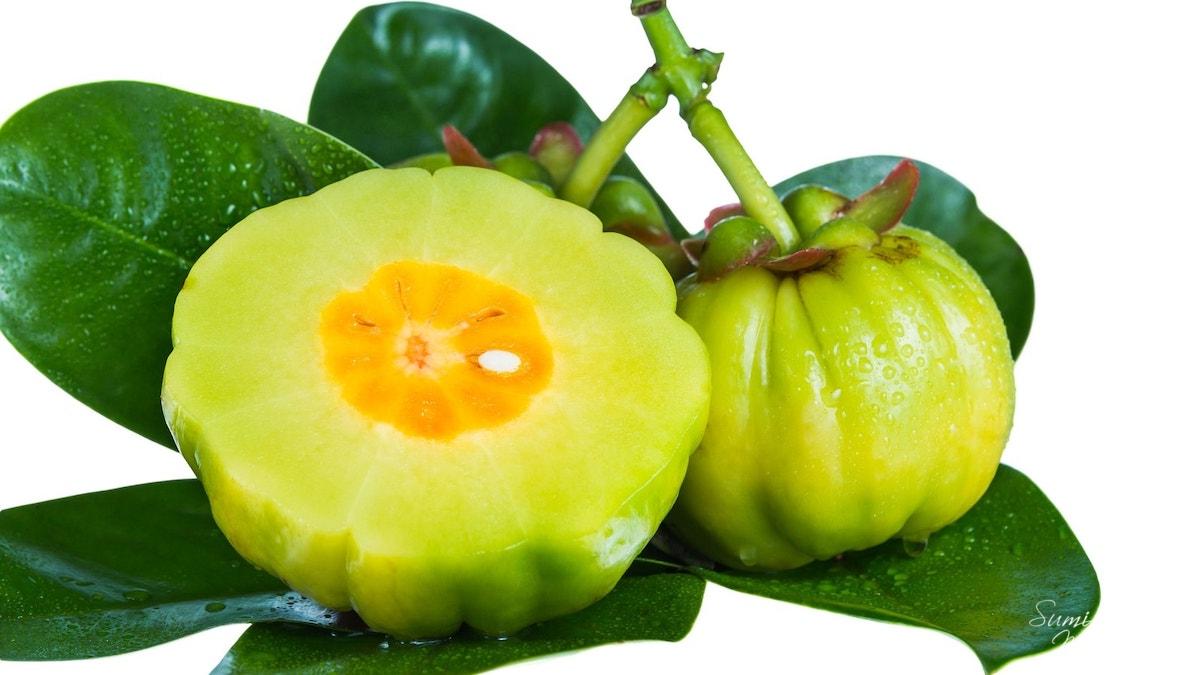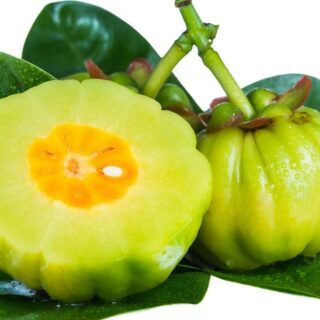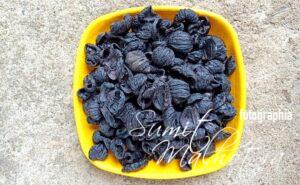All About Cambodge | Know Your Spice Kudampuli or Pot Tamarind (Garcinia cambogia)
All About Cambodge | Know Your Spice Kudampuli or Malabar Tamarind (Garcinia cambogia) – Cambodge or Malabar Tamarind or Kudampuli is a tropical fruit.
The cambodge berry, in yellow or red colour, has 6-8 grooves. It has blunt lobes with tough rind, succulent aril and 6-8 seeds. The rind is dried to obtain the spice.
The tree is a native of Western Ghats from Konkan to the south down to Kerala. It is a common tree in Kerala. Cambodge is also found largely in Karnataka.
Among the lesser known spices of India, Malabar Tamarind is one that stands unique for its culinary value and weight loss properties.
Primarily a souring agent it can be used as a substitute for Tamarind in many dishes. The rind of the Cambodge fruit contains Hydroxycitric acid (HCA) which is widely used in anti-obesity drugs.
What is the nutrition value of kudampuli?
The rind of kudampuli or Garcinia cambogia comprises of tannin (1.7%), pectin (0.9%), fat (1.4%), moisture (80.0 g/100 g), protein (1%) and sugars (4.1%).
The kodampuli seed is an excellent source of stearic triglycerides, stearic and oleic acid.
The leaves contain fiber (1.24 g), carbohydrates (17.2 g), moisture (75%), calcium (250 mg), protein (2.3 g), ascorbic acid (10 mg), fat (0.5 g), iron (15.14 mg), and oxalic acid (18.10 mg).
Also, malabar tamarind plant contains a trace amount of citric and hydroxycitric acid lactone.
What is the chemical composition of kudampuli?
Fruit extracts of Garcinia cambogia or Kudampuli are composed of reducing sugar, tartaric acid, euxanthone, camogin, fats and glucinol.
The leaves of cambodge in methanol, ethanol and acetone extracts exhibit a presence of alkaloids, steroids, cardiac glycosides, hydroxycitric acid (HCA), phenolic flavonoid, phlobatannin, protein, tannins & terpenoid.
The root of Malabar Tamarind or Cambodge comprises of the xanthone known as garbogiol while the bark of the stem contains benzophenones such as hydroxycitric acid(HCA), garcinol and isogarcinol.
The flower extract contains terpenoids, alkaloid, steroids, carbohydrate, phytosteroids, flavonoids, coumarins, phenol and proteins.
What is the English name for kudampuli?
Kudampuli or Pot Tamarind is commonly referred to as Malabar Tamarind, Fish Tamarind, Pot Tamarind or Kerala Tamarind in English.
Other names include Cambodge, Gambooge, Brindleberry, Goraka, Kodampuli, Kattcha puli (souring fruit), uppage and Gorikapuli. Garcinia gummi-gutta is it’s present scientific name while Garcinia cambogia.
What is the Kudampuli or Pot tamarind history & story?
There is an understanding built over centuries that a kudampuli tree can service every home it leans into.
Most Kerala households have a stockpile of the spice in the kitchen cupboard. Hoarding of kodampuli condiment is actively encouraged.
In fact, kudampuli goes wherever a Malayali goes — and that’s roughly true about the whole wide world.
Malabar tamarind tree is both magnificent and benevolent. It grows in abundance in Kerala and is zero-maintenance. When the yellow fruits plop to the ground, families scamper out to gather them.
The weight loss benefits of kudampuli fruit first came to light when in 2012, American celebrity doctor Dr. Oz promoted the extract from the fruit to achieve natural weight loss.
What are the uses of Cambodge or Malabar Tamarind?
With exceeding sharp but pleasant acidity the Cambodge fruit or Malabar Tamarind though edible, is eaten raw perhaps at meals.
Commercial brindleberry rind is loaded with considerable amounts of common salt, which is added during drying.
The fruits are acidic and are eaten raw or pickled.
The fleshy rind, fresh or after drying and smoking, is used as a condiment for flavoring curries and as a substitute for tamarind, mango and lime in various preparations requiring a sour taste.
In the Indian Ayurvedic system Cambodge fruit having sour taste are said to promote digestion.
Apart from these uses in food preparations and preservation, the Malabar Tamarind fruit juice possesses antiscorbutic, anthelmintic and cardiotonic properties.
Kudampuli is also used for polishing gold and silver ornaments and as a substitute for formic acid and acetic acid for coagulation of rubber latex.
The bark yields Gummi-gutta or Cambodge, which is mainly used as a pigment in miniature paintings and watercolors.
The timber of kudampuli is suitable for making match boxes, splints and posts. The grey, close-textured wood is moderately heavy.
Garcinia cambogia is a revolutionary component in nutraceutical 1 dietary supplement areas as a source of Hydroxycitric acid (HCA), which is known as a weight reducing agent.
What is the taste of kudampuli?
The fruit kodampuli gives a tart, smoky flavour to curries and tastes sour. The reason behind the sour taste is presence of hydroxycitric acid in the fruit.
Kudampuli is often mistaken for kokum or Garcinia indica because of similar characteristics and culinary uses.
However, they belong to the same family Clusiaceae, but Garcinia indica (kokum) and Garcinia cambogia (kodampuli) are not the same.
How long does kudampuli or malabar tamarind last?
Kudampuli fruit resembles a small pumpkin and it has an orange-yellow color when it ripens.
The separated fruit rind is sun dried for many days till it achieves a black color with no traces of yellowish color. It is then smoked or oven dried.
To increase the storage life, the dried rind is mixed with salt. In olden days the dried kudampuli was stored in a vessel called ‘bharani’. The dried kudampuli can be stored for many years.
How can I dry kudampuli at home?
Kudampuli is used in dry form like any other Indian spice. It goes through a long procedure to reach that form. The pumpkin-shaped kudampuli fruits are yellow in colour and more of a backyard crop in Kerala.
The ripe kodampuli fruit is deseeded & halved or sectioned and then spread in thin layers on pul paya or grass mats.
It is dried in the sun for three to seven days till the moisture level reaches about 15 to 20 percent.
It is then smoked daily on a wire mesh for several days. It is due to this kodampuli fruit turns black and gains a leathery texture in appearance.
After the smoking process kodampuli gets a good rub of coconut oil and salt for preservation and softening. It is then stored in huge ceramic pots (bharanis).
Is there a substitute for kudampuli or Malabar Tamarind?
The fruit kodampuli imparts a tart, smoky flavour to curries and tastes sour. The reason behind the sour taste is presence of hydroxycitric acid in the fruit.
Kudampuli is also often mistaken for kokum or Garcinia indica because of similar characteristics and culinary uses. This makes kokum an ideal substitute for kodampuli.
In case kokum is unavailable, a similar taste can be arrived at by using tamarind or even lemon.
What can I use kudampuli or pot tamarind for?
- Kudampuli is traditionally used as a souring agent in the preparation of curries & seafood preparations.
- It balances the taste in fish curries especially with coconut, hence it is known as fish tamarind also.
- An amazing and refreshing Summer drink similar to kokum juice is made with kudampuli.
- Kudampuli charu or strained extract syrup or concentrate is a healthy way to lose fats from the body. It is added to rasam and sambar for sourness.
What are the health benefits of Kudampuli or Cambodge or Goraka aka Malabar tamarind?
Health benefits of kudampuli or benefits of cambodge – Kudampuli or Malabar tamarind is mostly found in the Western Ghats from Konkan region in Karnataka to Trivandrum in Kerala and in Ooty in Tamil Nadu at highest altitudes.
From the leaves to the seed, kudampuli aka pot tamarind is considered a tonic for your body, mind, and spirit.
Different parts of the brindleberry plant are recommended for treating different conditions:
Many studies support the use of the entire plant of kudampuli aka brindleberry for human use and its therapeutic value. Here are some notable benefits of cambodge;
- Health benefits of cambodge in appetite control – One of the major functions of Kudampuli is to control your appetite. The acidic nature of the spice keeps you full as long as your body does not need an external food uptake.
- Health benefits of kudampuli with digestive ailments – Kudampuli clearly promotes your digestive health by preventing the growth of harmful intestinal parasites. In this way, it becomes easy to get rid of all the issues related to your digestion. Cambodge spice ensures that your bowel activity is improved.
- Health benefits of Garcinia cambogia against belly fat – If you are wary of fat around belly and buttocks, regular intake of Garcinia cambogia supplements could help in reducing in fat levels.
- Health benefits of kudampuli as antioxidant –Studies reveal that concentrated syrup extracted from Garcinia cambogia (kudampuli charu) is loaded with antioxidants that can effectively fight free radicals that can damage DNA, lipids, biomolecules and protein.
- Health benefits of cambodge in managing type 2 diabetes – It aids in improving insulin sensitivity, facilitates the flow of glucose to the cells, muscles and reduces the concentration of glucose in the blood.
- Health benefits of kudampuli for heart health –Numerous studies reveal that Garcinia cambogia plays an important role in bringing down the levels of bad or LDL cholesterol and triglycerides. Regular consumption of the fruit rind prevents the accumulation of fat in the liver, intestine and adipose tissue.
- Health benefits of Cambodge as a diuretic – Consuming Garcinia cambogia works as a diuretic thus increasing the urine output and clears extra water and electrolytes.
- Health benefits of kudampuli as an antacid – Kodampuli works as a natural antacid and facilitates proper digestion. Ayurvedic health experts suggest consuming fruit rind mixed with fresh curd and salt for instant relief from gastric ulcers and burning sensation in the tummy.
- Health benefits of Garcinia cambogia for rheumatoid arthritis – Applying the paste made from the rind of Garcinia cambogia provides relief from the pain caused due to arthritis. It is highly recommended for inflammation of the joints, bones and other rheumatic pains.
- Both the leaves and rind of Garcinia cambogia are known to have antifungal, astringent, thermogenic and digestive properties. The juice or sherbet made from the rind of this fruit is recommended for those suffering from digestive issues.
Kudampuli Charu | Kudampuli Syrup or Kudampuli Concentrate
Ingredients
- 100 gram Cambodge or Kudampuli or Kodampuli
- 4 Cup Water
Instructions
- Get your ingredients ready. Wash kudampuli thoroughly to remove any dirt
- Take the kudampuli and soak in water for 30-45 minutes.
- Mash these cambodge pieces and extract the water from it.
- Add water and repeat the process for 3-4 times to extract maximum content from it.
- Boil this extract for 10 minutes and allow it to settle down.
- Strain the mixture and store it in refrigerator.
- Use this tangy mixture in rasam or sambar or for kokum replacement in solkadhi.
Notes
- Kudampuli charu is considered to be a very good medicine not only for weight loss but also for arthritis and some type of uterine diseases.
- It also reduces the bad cholesterol in the body effectively. This fruit is considered as natural immunity builder.
Tools & Equipment Used For This Recipe
All About Cambodge | Know Your Spice Cambodge or Malabar Tamarind or Kudampuli (Garcinia cambogia) – Cambodge or Malabar Tamarind or Kudampuli is a tropical fruit.
The cambodge berry, in yellow or red colour, has 6-8 grooves. It has blunt lobes with tough rind, succulent aril and 6-8 seeds. The rind is dried to obtain the spice.
Kudampuli tree is a native of Western Ghats from Konkan to the south down to Kerala. It is a common tree in Kerala. Kudampuli is also found largely in Karnataka.
Among the lesser known spices of India, Malabar Tamarind is one that stands unique for its culinary value.
Primarily a souring agent Kudampuli can be used as a substitute for Tamarind in many dishes. The rind of the Cambodge fruit contains Hydroxycitric acid (HCA) which is widely used in anti-obesity drugs.
STAY CONNECTED
If you like this article, you can let us know in the comments below or on social media using #gosumitup and tag @gosumitup.
I am always happy to read your feedback and if you liked the dish or if you made the dish. :)
Better still, take a picture and post it on Instagram and tag it as #gosumitup
Connect direct – You can also connect with me directly on my Instagram and Facebook or on Pinterest.
And, keep visiting us for more of such awesomeness. Do bookmark gosumitup.com into your web browser now or simply subscribe to our browser notifications.
This article has been compiled for general information only and should not be used for the diagnosis or treatment of any medical condition/s.
This information is not intended to diagnose, treat, cure, or prevent any disease.
GoSumItUp.com has used all reasonable care in compiling the information but offers no warranty as to its accuracy or its use in any possible form.
Consult a doctor or other health care professional for diagnosis and treatment of any medical condition/s. For more details please refer to our disclosure policy.







